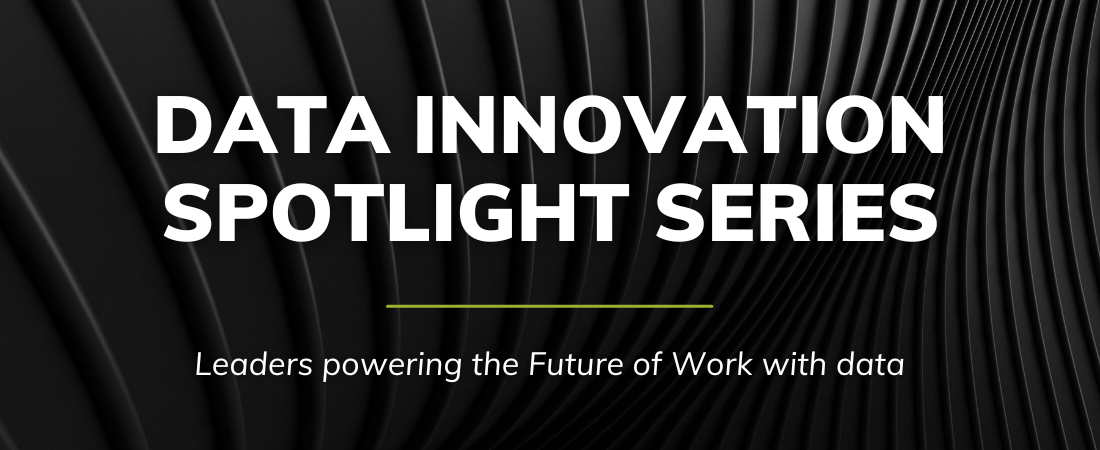**A recurring series to spotlight the leaders who are shaping the Future of Work through the lens of data. Today’s profile features Steve Stano, a B2B & SaaS data-driven marketer and storyteller**
Steve! I’m so excited to feature you in this series. Not only did we learn that we grew up about 6 miles apart from each other in the great state of New York, but we also have both built our careers around marketing, storytelling, and strategy. As always, I like to start by offering our readers a glimpse into your career — everything from how you got into marketing to the motivators that have inspired your career decisions.
 Steve Stano: For as long as I can remember, I wanted to be on Wall Street. So, when I graduated college, I entered into a two-year rotational program at Citigroup and did everything from Teller to Branch Manager before moving to corporate where I got my first taste of marketing. Coming out of this rotational program, I held several marketing roles including Marketing Manager for Citigroup’s financial wellness product and Product Marketer for their global fund transfer products.
Steve Stano: For as long as I can remember, I wanted to be on Wall Street. So, when I graduated college, I entered into a two-year rotational program at Citigroup and did everything from Teller to Branch Manager before moving to corporate where I got my first taste of marketing. Coming out of this rotational program, I held several marketing roles including Marketing Manager for Citigroup’s financial wellness product and Product Marketer for their global fund transfer products.
But where my career took off was 10 years ago when I joined one of the largest financial services firms on Wall Street and landed in B2B marketing. While I started out supporting marketing for a newly formed corporate solutions business, I ended up growing into several leadership roles. Today, my team cuts across several verticals including acquisition marketing, client marketing, event & experiences, and communications, with a side hustle focusing on research and market intelligence.
The transition to a leadership role was largely influenced by being a good leader, delivering on what you say you’re going to, listening to your partners, and forming strong relationships with peers and influencers that recognize the strategic value you bring to the table.
Marketing has gone through such an evolution over the years — particularly with the advent of data, analytics, and predictive intelligence. When you look at the industry and the pivotal shifts that have occurred, I’m curious, which have most stuck out to you?
SS: I remember the early days of Marketing where the function operated like a fulfillment center; the business had an order, and your job was to meet the order. Whereas today, Marketing is a contributor to strategic decisions and business growth, and that’s powered through data, insights and intelligence. It’s about marrying the subjective, based on your experience, with the objective, based on data.
Like any Marketing function, there are many requests that come our way and being a good partner to the business, you always want to say ‘yes, we can help you.’ But to avoid that fulfillment dilemma, I’ve found that when managing requests, I reflect on our reasons to exist as a team and the ways we can help drive growth.
A big part of that equation is ensuring that we take a data-backed approach to everything we do. As an example, if we’re targeting private companies across paid and organic media channels, the question I often ask is how can we leverage data to influence the content and messaging we push into market. In turn, this helps the team think through the connection of marketing with data and using it as a way to drive performance.
As you’ve lived through that journey — especially the marrying of subjective with the objective — how specifically have you cultivated your data-based leadership? It’s clear from following your work online (from your speaking engagements to LinkedIn posts to podcast features) that you’re super passionate about the way data can power a marketer’s job. To where do you attribute that passion?
SS: The inquisitive nature has always been a part of me so being able to access data and see the big picture based on my understanding of the business was a key turning point. I often ask is ‘How do we pull the thread through to tell a larger story?’ An example of this is the connection of data points on corporates we’re targeting with paid media to intent data. By making that connection we’re able to identify corporates who are showing signs of making a purchasing decision and providing that intelligence to our Sales teams so they can reach out to them with highly curated content.
That connection is the new frontier in marketing.
To build on this, I recently read PwC’s pulse report on CMOs and it shared that 40% of CMOs strongly agree that the value of marketing is understood by key decision makers in their company. This declined from 54% in 2023. Additionally, 78% of CMOs say making their function a more strategic business partner to their business leaders is a medium or high priority.
The opportunity here is significant. Educate and engage decision makers on the power of marketing, through data, in a way they can consume and understand it. This will take you much further, faster.
Those are some great and relevant statistics that indicate that Marketing, as a function, is aware of the importance of continually strengthening their value and positioning. We’re seeing similar trends across other functions and data can be a powerful accelerator to help functions drive influence. What advice would you give to any leader — regardless of title — who is looking to strengthen their data-driven leadership.
SS: Three things: Own it. Ask questions. Don’t be afraid. So, what do I mean by that?
Own it in that you don’t need to be a data researcher or analyst, but what you can do is look at data to tell a story. Secondly, ask questions. If you don’t know, or have, the answer, ask a question. And then finally, don’t be afraid of data. Yes, it can be a lot of quantitative or qualitative inputs, but center yourself around your key reasons to exist. If you know why you exist and what leadership cares about, then it’s easier to parse through data to unlock the insights that you need to move forward.
Along those lines, knowing that the data landscape is shifting so fast, how do you stay informed?
SS: Engaging with experts is one of the key ways I stay informed on how the data landscape is shifting. Another is proactive education and LinkedIn has become an incredible source of information to stay informed on how the landscape is shifting. You have direct access to thousands of thought leaders that span multiple industries, company sizes, and experience. Connect with those that you’re eager to learn from and use the platform as a way to grow your skillset.
As you were sharing, I was reflecting on how so many folks think of data is bits and bytes, right? Data is a number that I can see. It’s a report. It’s a visualization. But something that we’re passionate about educating people on is that data is all around you. You and me — we are creating data right now. We’re sharing information. And sure it’s unstructured, but there’s a story right here that’s going to come out our conversation. So, I love what you said about feedback because we often don’t think about feedback as data but that’s exactly what it is!
SS: 100%. This whole conversation was a data exchange! Folks shouldn’t underestimate this. Focus on the story that you are trying to tell and start there. I often tell my team, know your audience, and anticipate the questions they’ll ask or the updates they’re looking for.
OK, my final question, how do you define data innovation? What does it mean to you?
SS: Data innovation is thinking beyond numbers. It’s about combining insights to tell a more connected story across quantitative with qualitative inputs. Some may say that’s challenging but it’s entirely possible. Think about all the data at your fingertips today – from a quantitative perspective this could include business performance, wins, assets under management, engagement rates and more. But, you also have access to qualitative inputs from the marketplace, prospects, and tenured clients. Innovation doesn’t always need to come from evolution in technology; it can come from the way you gather and harness data to drive impact and growth.
Also From the Series:

